Abandoned Places in Florida Introduction
Discover the top 10 abandoned places in Florida for urban explorers. From eerie ghost towns to mysterious structures, explore Florida’s forgotten history…
Are you ready to step into a world frozen in time, where echoes of the past linger in the air and stories of yesteryear wait to be discovered? Florida, known for its sun-soaked beaches and vibrant cities, holds a secret world of abandoned places, beckoning urban explorers to uncover its hidden gems. From the hauntingly beautiful Belleview Biltmore Hotel to the mysterious Dome Houses of Cape Romano, each site tells a tale of its own, offering a glimpse into Florida’s forgotten history.
Urban exploration, or Urbex, has surged in popularity as adventurers seek to peel back the layers of time and reveal the stories that lie beneath. Florida’s rich history, dotted with abandoned structures and forgotten relics, provides a playground for those with a sense of adventure and a curiosity for the past.
Join us on a journey through the top 10 must-visit abandoned places in Florida, where each site offers a glimpse into a bygone era. But beware, as you step into these abandoned spaces, you may find yourself captivated by the allure of the past and the stories waiting to be told.
The Belleview Biltmore Hotel
History of the hotel and its significance. Details on its current abandoned state and urban exploration opportunities.
Nestled in the heart of Belleair, Florida, the Belleview Biltmore Hotel stands as a silent sentinel to a bygone era of luxury and grandeur. Once known as the “White Queen of the Gulf,” this historic hotel welcomed guests from around the world, including celebrities and dignitaries. Today, its abandoned halls and faded elegance offer a haunting glimpse into the past, making it a must-visit destination for urban explorers.
History and Significance:
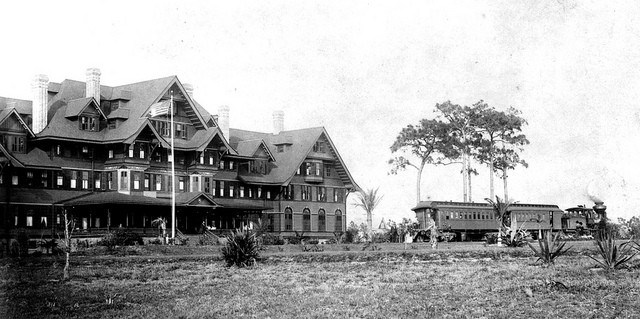
Built-in 1897 by railroad tycoon Henry B. Plant, the Belleview Biltmore Hotel was a testament to the Gilded Age’s opulence and sophistication. Its stunning architecture and lavish amenities attracted the elite of society, establishing it as a premier destination along Florida’s Gulf Coast. Over the years, the hotel underwent several expansions and renovations, further enhancing its reputation as a luxurious retreat.
Current Abandoned State and Urban Exploration Opportunities:
Despite its illustrious past, the Belleview Biltmore Hotel closed its doors to guests in 2009, succumbing to financial struggles and neglect. Since then, the hotel has stood empty, slowly deteriorating as nature and time take their toll. Urban explorers who venture inside will find a mix of faded grandeur and eerie emptiness, with crumbling walls and faded wallpaper telling the story of its decline.
Urban Exploring: A Beginner’s Guide to Thrilling Discovery 2024
Safety Tips and Regulations:
Exploring the Belleview Biltmore Hotel can be a thrilling experience, but it’s essential to prioritize safety. The building’s structural integrity may be compromised, so it’s crucial to watch your step and avoid areas that appear unsafe. Additionally, be aware of local regulations regarding trespassing and obtain any necessary permissions before entering the property. By respecting the hotel’s history and taking precautions, urban explorers can safely enjoy the Belleview Biltmore Hotel’s haunting beauty.
VISIT >> Belleview Biltmore Golf Club Tours
St. Nicholas Coal Breaker
Deep in the heart of Pennsylvania’s coal country lies a relic of the industrial revolution – the St. Nicholas Coal Breaker. Once a bustling hub of coal mining activity, this massive structure now stands abandoned, a silent witness to a bygone era. Urban explorers who venture inside will find themselves transported back in time, surrounded by the remnants of a once-thriving industry.
Historical Background:
Built in 1931, the St. Nicholas Coal Breaker was one of the largest coal breakers in the world, processing millions of tons of coal each year. The breaker played a crucial role in the region’s economy, providing jobs for thousands of workers and fueling the nation’s growing demand for coal. However, as the coal industry declined, so too did the breaker, eventually closing its doors in 1972.
Current Condition and Exploration Opportunities:
Today, the St. Nicholas Coal Breaker stands as a haunting reminder of the region’s industrial past. Urban explorers who brave its dark corridors will find themselves surrounded by towering machinery and crumbling infrastructure. The breaker’s massive coal chutes and conveyor belts offer a glimpse into the scale of its operations, while the eerie silence of its abandoned halls echoes with the voices of the past.
Safety Precautions:
Exploring the St. Nicholas Coal Breaker can be a dangerous endeavor, as the structure is in a state of severe disrepair. Urban explorers should exercise caution at all times, watching for unstable floors, falling debris, and other hazards. It’s also important to respect the property and its history, taking care not to disturb or damage any artifacts. With proper precautions, urban explorers can safely experience the St. Nicholas Coal Breaker’s haunting beauty and gain a deeper appreciation for the region’s industrial heritage.
Miami Marine Stadium
History of the stadium and its architecture. Discussion on its abandonment and current status.
Nestled on the shores of Biscayne Bay in Miami, Florida, lies a unique and iconic structure – the Miami Marine Stadium. Built-in 1963, the stadium was a marvel of modern architecture, with its floating stage and sweeping cantilevered roof. Over the years, the stadium hosted concerts, boat races, and other events, becoming a beloved landmark in the Miami community. However, in 1992, Hurricane Andrew struck, causing extensive damage to the stadium and leading to its abandonment.
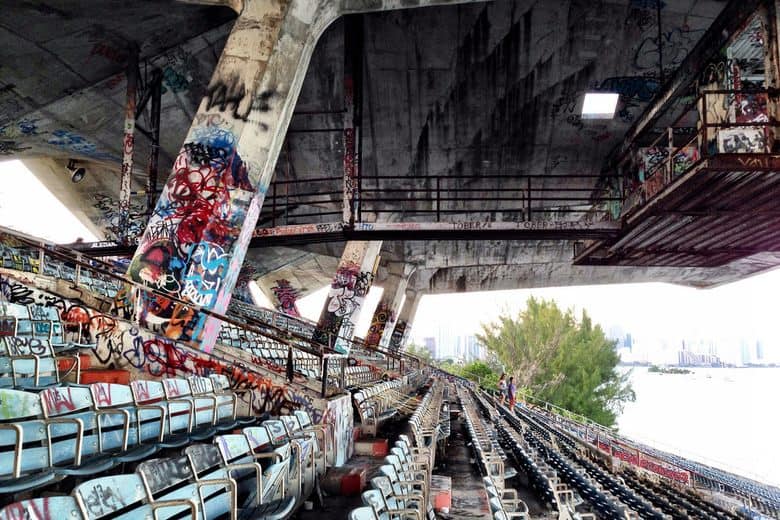
History and Architecture:
Designed by architect Hilario Candela, the Miami Marine Stadium was a pioneering example of modernist architecture. Its unique design allowed for unobstructed views of the bay and the downtown Miami skyline, making it a popular venue for events. The stadium’s floating stage, which could be raised or lowered as needed, added to its versatility and appeal.
Abandonment and Current Status:
Following Hurricane Andrew, the Miami Marine Stadium was deemed unsafe and closed to the public. Despite efforts to restore the stadium, including a listing on the National Register of Historic Places, it has remained abandoned for over two decades. Today, the stadium stands as a graffiti-covered shell of its former self, a haunting reminder of its once-vibrant past.
Graffiti Art and Urban Culture:
One of the most striking features of the Miami Marine Stadium is the vibrant graffiti art that adorns its walls. Over the years, street artists from around the world have used the stadium as a canvas, creating stunning works of art that add to its allure. The stadium has become a mecca for urban art enthusiasts, with new pieces constantly being added and evolving.
Exploring the Stadium:
Urban explorers who venture inside the Miami Marine Stadium will find themselves surrounded by a kaleidoscope of color and creativity. The stadium’s graffiti-covered walls offer a glimpse into Miami’s vibrant street art scene, with each piece telling its own story. However, exploring the stadium can be dangerous, as its structure is deteriorating. Urban explorers should exercise caution and respect the property while enjoying its artistic beauty.
The Dome Houses of Cape Romano
Off the coast of Marco Island in Southwest Florida, a cluster of dome-shaped structures stands as a testament to both architectural innovation and the relentless march of time. These are the Dome Houses of Cape Romano, a fascinating and somewhat eerie sight that has captured the imagination of many. Built in 1980 by retired oil producer Bob Lee, these structures were intended to be a vacation home for his family. However, due to coastal erosion and shifting sands, the houses were abandoned in the early 1990s.
Unique Architecture and History:
The Dome Houses of Cape Romano are a unique example of innovative architecture, with their dome-shaped structures and concrete construction. The design was ahead of its time, incorporating solar panels and other eco-friendly features. Despite their abandonment, the houses remain remarkably intact, a testament to their sturdy construction and the harsh coastal environment they have endured.
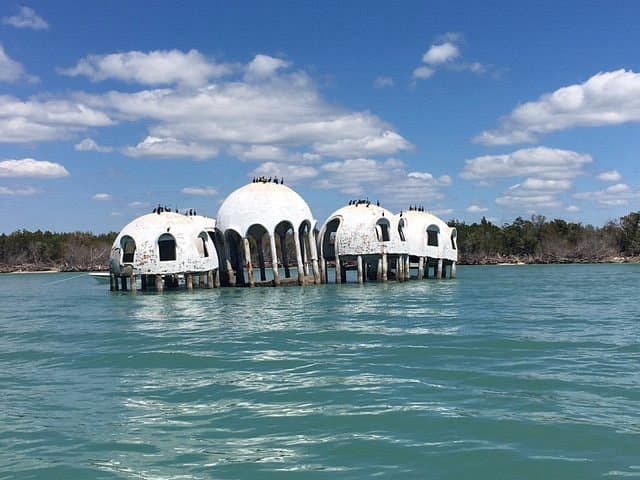
Reasons for Abandonment and Current Condition:
The Dome Houses were abandoned due to the encroaching waters of the Gulf of Mexico, which threatened to swallow them whole. Today, they stand partially submerged, a surreal sight that is both beautiful and haunting. The houses have become a popular destination for kayakers and boaters, who come to explore these ghostly structures and ponder their mysterious past.
Accessibility and Safety Considerations:
While the Dome Houses of Cape Romano are accessible by boat, getting too close can be dangerous due to the submerged portions and shifting sands. It’s important for visitors to exercise caution and respect the fragile nature of these structures. Additionally, the houses are located within the Rookery Bay National Estuarine Research Reserve, so visitors should be mindful of any regulations or restrictions in place to protect the environment.
Conclusion:
The Dome Houses of Cape Romano are more than just abandoned structures; they are a testament to the power of nature and the resilience of human creativity. As these structures slowly succumb to the sea, they serve as a poignant reminder of the fragility of our built environment and the inexorable forces of change.
Visit >> The DOME Adventure
Central Florida Railroad Museum
Located in the heart of Central Florida, the Central Florida Railroad Museum is a hidden gem that offers a fascinating glimpse into the region’s rich railroad history. Housed in a historic train depot, the museum is home to a collection of artifacts, photographs, and memorabilia that tell the story of Central Florida’s railway heritage. From the golden age of steam locomotives to the modern era of diesel engines, the museum’s exhibits provide a comprehensive look at the impact of the railroad on the region’s development.
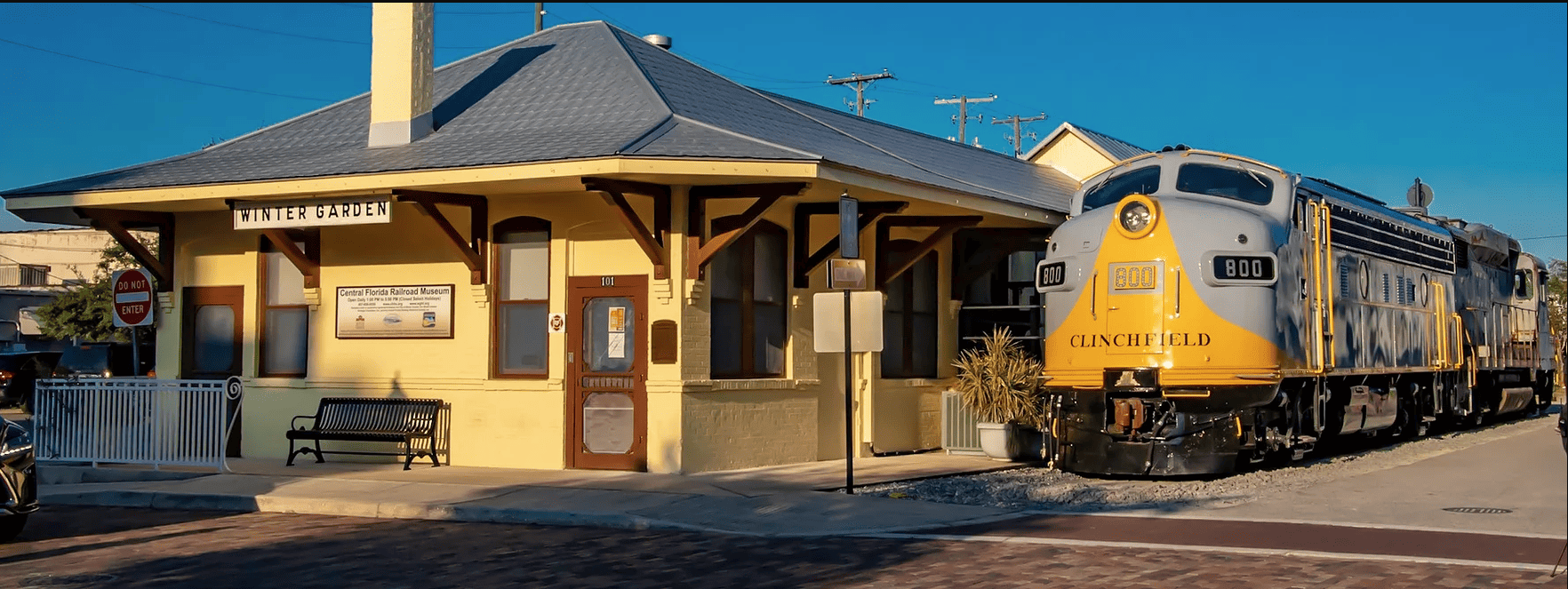
History and Collection:
The Central Florida Railroad Museum is located in the former Tavares and Gulf Railroad depot, which was built in 1913. The depot served as a hub for passenger and freight trains, playing a vital role in the region’s transportation network. Today, the museum’s collection includes a variety of artifacts, including vintage railroad equipment, tools, and uniforms. The museum also features a model railroad display that showcases the intricacies of railroading in miniature.
Abandonment and Current Condition:
The Central Florida Railroad Museum is a testament to the region’s railway history, but it also serves as a reminder of the decline of the railroad industry in the United States. As railroads were replaced by highways and air travel, many depots and stations fell into disuse and disrepair. The museum’s location in a historic depot is a nod to this past, preserving a piece of Central Florida’s history for future generations to enjoy.
Exploration and Preservation Efforts:
Visitors to the Central Florida Railroad Museum can explore the exhibits and learn about the region’s railroad history through interactive displays and guided tours. The museum also hosts special events and educational programs that highlight the importance of railroads in shaping Central Florida’s past and present. By preserving this history, the museum ensures that the legacy of the railroad will continue to be celebrated and appreciated for years to come.
VISIT >> Central Florida Railroad Museum Tours
Pennsuco Cement Plant
Nestled amidst the lush greenery of South Florida lies a towering industrial relic – the Pennsuco Cement Plant. Once a bustling hub of cement production, this massive facility now stands silent and abandoned, a testament to a bygone era of industry. For urban explorers, the Pennsuco Cement Plant offers a fascinating glimpse into the region’s industrial past, with its towering structures and decaying machinery.
Historical Background:
The Pennsuco Cement Plant was built in the 1920s and played a crucial role in supplying cement for the construction boom in South Florida. Its location near limestone deposits made it an ideal site for cement production, and the plant thrived for decades, supplying materials for countless buildings and infrastructure projects. However, as the demand for cement shifted and newer facilities were built, the Pennsuco Cement Plant eventually closed its doors in the 1990s.
Abandoned State and Exploration Opportunities:
Today, the Pennsuco Cement Plant stands as a haunting reminder of its industrial past. Urban explorers who venture inside will find themselves surrounded by towering silos, rusting machinery, and empty buildings. The plant’s massive kilns and conveyors offer a glimpse into the scale of its operations, while the silence of its abandoned halls speaks volumes about its decline. Exploring the plant can be a thrilling experience, but it’s important for visitors to exercise caution, as the structures are deteriorating and unstable.
Safety Precautions:
Exploring the Pennsuco Cement Plant can be a dangerous endeavor, as the site is in a state of severe disrepair. Urban explorers should watch their step and avoid areas that appear unstable or unsafe. It’s also important to respect the property and its history, taking care not to disturb or damage any artifacts. By exploring responsibly and taking precautions, urban explorers can safely enjoy the Pennsuco Cement Plant’s industrial beauty and gain a deeper appreciation for the region’s industrial heritage.
The Dome Home in Pensacola

In the quiet coastal town of Pensacola, Florida, sits a curious architectural wonder – the Dome Home. Resembling something out of a science fiction movie, this unique structure has captured the imagination of many. Built in the 1980s by a retired pilot, the Dome Home was designed to withstand hurricanes and offer a sustainable living space. However, due to zoning issues and its unconventional design, the Dome Home was eventually abandoned, leaving behind a fascinating piece of Pensacola’s architectural history.
History and Unique Architecture:
The Dome Home’s spherical design was not just for aesthetics; it was also a practical choice to withstand the harsh coastal environment. The structure is made of concrete and fiberglass, providing durability and resistance to hurricanes. Inside, the Dome Home features open living spaces and curved walls, creating a unique and unconventional living experience. Despite its abandonment, the Dome Home remains structurally sound, a testament to its innovative design.
Reasons for Abandonment and Current Condition:
The Dome Home was abandoned due to zoning issues and legal battles with the local government. Today, the structure stands empty, its white dome contrasting against the blue sky and sandy beaches of Pensacola. The Dome Home has become a popular destination for urban explorers and photographers, who are drawn to its futuristic appearance and mysterious past.
Accessibility and Safety Tips:
Access to the Dome Home is restricted, as it is located on private property. Urban explorers should respect the property owner’s rights and not attempt to enter the structure without permission. Additionally, the Dome Home is located near the water, so visitors should be mindful of the tides and potential hazards. While exploring the exterior of the Dome Home can be a fascinating experience, it’s important to prioritize safety and respect for the property.
Fort Dade on Egmont Key
Situated on the picturesque Egmont Key off the coast of St. Petersburg, Florida, lies the historic Fort Dade. Built in the late 19th century, Fort Dade served as a strategic military outpost, protecting the entrance to Tampa Bay during times of war. Today, the fort stands abandoned, a silent sentinel to a bygone era of coastal defense. For urban explorers, Fort Dade offers a unique opportunity to step back in time and explore a piece of Florida’s military history.
Historical Significance of Fort Dade:
Constructed in 1898 during the Spanish-American War, Fort Dade was part of a network of coastal defenses designed to protect the United States’ coastline. The fort was equipped with artillery batteries, barracks, and support buildings, making it a formidable defense post. Throughout its history, Fort Dade played a key role in protecting Tampa Bay and the surrounding area from potential threats.

Abandonment and Current State:
After the end of World War II, Fort Dade was gradually decommissioned and abandoned. Today, the fort’s buildings stand empty and in various states of decay, with nature slowly reclaiming the island. Urban explorers who venture to Egmont Key can explore the fort’s ruins, including its crumbling walls and overgrown courtyards, gaining a glimpse into its military past.
Accessibility and Risks:
Access to Egmont Key and Fort Dade is restricted, as the island is part of a wildlife refuge and protected area. Visitors can reach the island by boat or ferry, but exploring the fort’s ruins can be challenging due to its deteriorating condition. Urban explorers should be mindful of the uneven terrain and potential hazards, such as falling debris or unstable structures. Despite these risks, exploring Fort Dade offers a unique opportunity to connect with Florida’s military history and experience a sense of adventure on this remote island.
VISIT >> Egmont Key State Park, FL
The Coral Castle: A Monument of Mystery and Intrigue
Nestled in Homestead, Florida, The Coral Castle stands as a testament to one man’s remarkable vision and determination. Built by Edward Leedskalnin, a Latvian immigrant, The Coral Castle is a stunning display of intricate sculptures and structures made entirely of coral rock. What makes this feat even more astonishing is that Leedskalnin single-handedly carved and constructed the entire castle, working mostly at night and in secret.
Eccentric Creation of Edward Leedskalnin:
Edward Leedskalnin began construction of The Coral Castle in the early 1920s and continued until his death in 1951. The castle features numerous megalithic stones, some weighing as much as 30 tons, intricately carved and balanced to create walls, towers, and even furniture. Leedskalnin’s methods for moving and shaping the massive stones remain a mystery, as he reportedly worked alone and did not allow anyone to observe his methods.
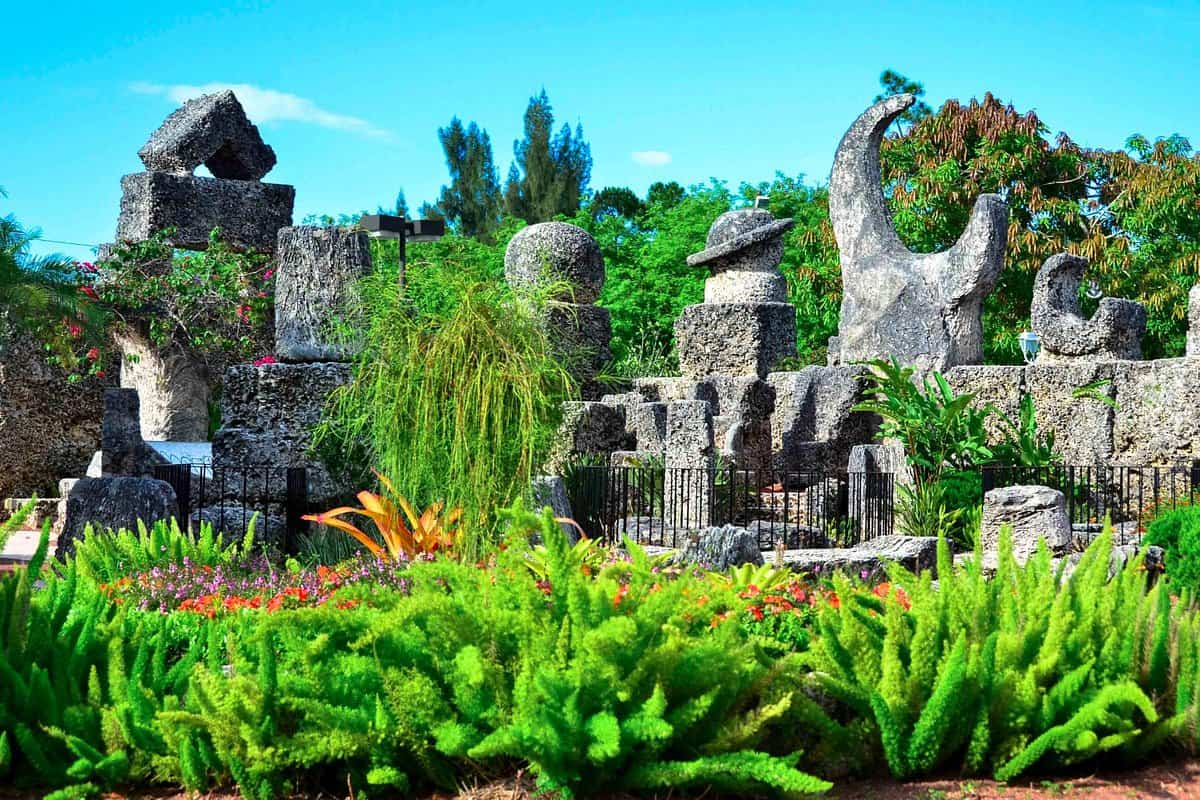
Historical and Artistic Significance:
The Coral Castle has garnered significant historical and artistic interest due to its unique construction and the mystery surrounding its creation. Some theories suggest that Leedskalnin possessed advanced knowledge of magnetism and leverage, allowing him to move the massive stones with relative ease. Others speculate that he may have had help from extraterrestrial or supernatural forces. Despite ongoing debate and scientific analysis, no definitive explanation has been reached, adding to the allure of The Coral Castle.
Ongoing Debate and Mystery:
The debate over how Edward Leedskalnin constructed The Coral Castle continues to intrigue historians, scientists, and visitors alike. The sheer scale and precision of the structures defy conventional explanations, leading many to believe that Leedskalnin possessed a knowledge or technique that has since been lost or forgotten. Whether the result of ingenuity, supernatural forces, or a combination of both, The Coral Castle stands as a testament to human creativity and the enduring allure of mystery.
Weeki Wachee Springs Hospital: A Haunting Reminder of the Past
Tucked away in the serene surroundings of Weeki Wachee Springs, Florida, lies a forgotten relic of medical history – the Weeki Wachee Springs Hospital. Once a bustling medical facility, this hospital now stands abandoned, its halls echoing with the whispers of the past. The hospital’s eerie atmosphere and mysterious past have captured the imaginations of urban explorers and thrill-seekers alike, drawing them to its decaying corridors in search of answers.
A Mysterious and Forgotten Medical Facility:
The Weeki Wachee Springs Hospital was originally built in the early 1900s to serve the local community and provide medical care to those in need. Over the years, the hospital expanded to accommodate a growing population, with additional wings and facilities added to meet the demand for healthcare services. However, as medical practices evolved and the population shifted, the hospital fell into disuse and was eventually abandoned.
Ongoing Debate about Legality and Safety:
The Weeki Wachee Springs Hospital has become a popular destination for urban explorers, photographers, and paranormal enthusiasts seeking to uncover its secrets. However, the legality and safety of exploring the abandoned hospital have been subjects of debate. Some argue that exploring the hospital is trespassing and illegal, as the property is privately owned. Others raise concerns about the safety of the decaying structure, citing risks of collapse and hazardous materials.
Despite these concerns, the allure of the Weeki Wachee Springs Hospital persists, drawing adventurers and history buffs to its doorstep. As the debate continues, the hospital remains a haunting reminder of a bygone era, its faded walls and empty rooms serving as a testament to the passage of time.
Conclusion of Abandoned places in Florida
As we conclude our journey through the top 10 must-visit abandoned places in Florida for urban explorers, we reflect on the rich history and haunting beauty of these forgotten sites. Each location offers a unique glimpse into Florida’s past, showcasing the state’s diverse heritage and the stories of those who came before us. From the grandeur of the Belleview Biltmore Hotel to the mysterious Dome Houses of Cape Romano, these abandoned places stand as testaments to the passage of time and the resilience of the human spirit.
Recap of Must-Visit Abandoned Places:
Throughout this exploration, we have uncovered the secrets of some of Florida’s most intriguing abandoned sites. We have marveled at the architectural wonders of the Miami Marine Stadium and pondered the mysteries of the Coral Castle. We have stepped back in time at the Central Florida Railroad Museum and braved the elements at Fort Dade on Egmont Key. Each location has offered a unique experience, enriching our understanding of Florida’s history and the people who shaped it.
Encouragement for Responsible Exploration:
As urban explorers, it is our responsibility to approach these abandoned places with respect and reverence. We must tread lightly, leaving no trace of our presence and taking care not to disturb or damage these fragile sites. By exploring responsibly, we can ensure that these abandoned places remain accessible for future generations to enjoy and learn from. So, whether you are a seasoned urban explorer or a curious traveler, we invite you to embark on your own journey of discovery and uncover the hidden treasures of Florida’s abandoned places.
Invitation to Share Experiences:
We also invite you to share your own urban exploration experiences in Florida. Whether you have visited one of the places mentioned in this article or discovered a hidden gem of your own, we would love to hear from you. Your stories and insights can help enrich our understanding of Florida’s abandoned places and inspire others to embark on their own adventures. Together, let’s continue to explore, discover, and preserve the history of Florida’s abandoned places for generations to come.

